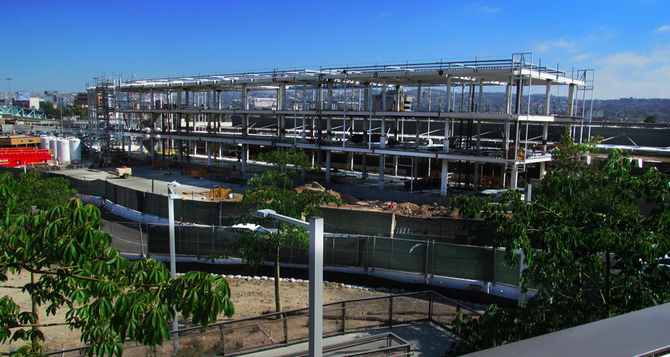 Facebook
Facebook
 X
X
 Instagram
Instagram
 TikTok
TikTok
 Youtube
Youtube

Border construction projects by the governments of the U.S. and Mexico were advancing at a rapid clip through the month of June.
On the U.S. side, in San Ysidro, the three-story superstructure of the new border-crossing station has risen up in a scant two months. The rectangular structure is located adjacent to the recently completed and now actively in-use Secondary Inspection “barn” with its billowing canopy roof.
On the Mexican side, a new pedestrian-entry building is nearing exterior completion; recently poured concrete walls envelope its steel skeleton. The building is visible when crossing by foot into Mexico from San Ysidro.
Another Mexican project, a widening of the Via Internacional, the most commonly used route to the Playas area of Tijuana, is undergoing modifications that involve the laying of a concrete roadbed and the creation of a center divider.
The highway receives heavy traffic, particularly during horas picas (rush hours) and weekends. The road is also one of the main tributaries of the Chaparral project, which routes traffic from the new Mexican border-crossing station.
Visitors from the north now enter the Chaparral conduit, go over the Tijuana River by bridge, and then drop down onto the Via Internacional. (This horseshoe-shaped bridge has been added to Google Maps, its route running parallel to the pedestrian bridge labeled “El Chaparral.”)


Border construction projects by the governments of the U.S. and Mexico were advancing at a rapid clip through the month of June.
On the U.S. side, in San Ysidro, the three-story superstructure of the new border-crossing station has risen up in a scant two months. The rectangular structure is located adjacent to the recently completed and now actively in-use Secondary Inspection “barn” with its billowing canopy roof.
On the Mexican side, a new pedestrian-entry building is nearing exterior completion; recently poured concrete walls envelope its steel skeleton. The building is visible when crossing by foot into Mexico from San Ysidro.
Another Mexican project, a widening of the Via Internacional, the most commonly used route to the Playas area of Tijuana, is undergoing modifications that involve the laying of a concrete roadbed and the creation of a center divider.
The highway receives heavy traffic, particularly during horas picas (rush hours) and weekends. The road is also one of the main tributaries of the Chaparral project, which routes traffic from the new Mexican border-crossing station.
Visitors from the north now enter the Chaparral conduit, go over the Tijuana River by bridge, and then drop down onto the Via Internacional. (This horseshoe-shaped bridge has been added to Google Maps, its route running parallel to the pedestrian bridge labeled “El Chaparral.”)
Comments